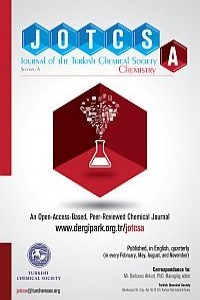THE ORIGIN OF THE TOTAL ALPHA AND BETA RADIATION VALUES OF THE WATERS OF ÇANAKKALE STRAIT (ÇANAKKALE/TURKEY)
THE ORIGIN OF THE TOTAL ALPHA AND BETA RADIATION VALUES OF THE WATERS OF ÇANAKKALE STRAIT (ÇANAKKALE/TURKEY)
This study is an evaluation of radioactivity the waters of the Çanakkale Strait. The total alpha- and total beta-radioactivity counts (Berthold, LB770-PC 10-Channel Low-Level Planchet Counter) were calculated for seawater samples taken from eight different regions of the Çanakkale Strait (Şevketiye, Seddülbahir, Lapseki, Kumkale, Burhanlı, Dereliman, Eceabat and Gelibolu). In the samples, the total alpha-radiation ranged between 0.064 and 0.046 Bq/L and the total beta-radiation ranged between 14.325 and 10.532 Bq/L. The highest total alpha-radiation concentration was measured at Gelibolu (0.064 Bq/L) while the lowest (0.046 Bq/L) was measured at Şevketiye. The highest value for total beta-radiation concentration (14.325 Bq/L) was measured in Seddülbahir and the lowest value (10.532 Bq/L) was measured in Dereliman. The total alpha-radiation concentrations measured by the Turkish Atomic Energy Authority in Çanakkale’s drinking and utility water ranged between 0.05 and 0.400 Bq/L, and the highest values (0.300 to 0.400 Bq/L) were found in the Ezine county. Total beta-radiation concentrations ranged from 0.05 to 0.500 Bq/L, and the highest values (from 0.400 to 0.500 Bq/L) were recorded in Lapseki province. The total beta-radiation concentrations in both the sample results and TAEK data were determined to be high in Lapseki and its vicinity. Comparing the mean total beta- and alpha-radiation concentration values of the Çanakkale Strait with the Bosphorus, the Sea of Marmara and the Black Sea, beta-radiation values in the study area were very high. Total alpha-radiation results were low in the study area compared to other areas. Evaluating the results against the legal limit threshold, the results were above the legal limit for total beta-radiation. This result indicates that the water is affected by the rocks through which it passes.
___
- Yümün, Z.Ü. (2017). The Effect of Heavy Metal Pollution on Foraminifera in the Western Marmara Sea (Turkey), Journal of African Earth Sciences - Elsevier, 129 346-365.
- [15] Artüz, L. M., 2007, Bilimsel Açıdan Marmara Denizi. Turkish Bar Association Publications, 119 (2),.
- Taşkın, H., Kam, E, Bozkurt, A. (2012). Determination of Gross Alpha and Beta Activitiy Concentrations in Drinking Waters in Bursa Region of North-Western Turkey. Desalination and Water Treatment. 45,21-25.
- Taşkın, H., Aslıyüksek, H., Bozkurt, A., Kam, E. (2013). Natural radıoactıvıty ın bottled mineral and thermal sprıng waters of turkey. Radiation Protection Dosimetry, 157 (4), 575–578.
- Başlangıç: 2014
- Yayıncı: Türkiye Kimya Derneği
Sayıdaki Diğer Makaleler
Ahmet GÜNGÖR, Rükan GENÇ, Tonguç ÖZDEMİR
Some Heavy Metal Contents of Various Slaughtered Cattle Tissues in Sivas-Turkey
Tulay Oymak, Halil İbrahim Ulusoy, Emre Hastaoglu, Vedat Yılmaz, Şahin Yıldırım
Zakaria BENZEKRİ, Houda SERRAR, Said BOUKHRİS, Abdelaziz SOUİZİ
Adedirin Oluwaseye, Adamu Uzairu, Gideon A. Shallangwa, Stephen E. Abechi
Erol KAM, Zeki. Ü. YÜMÜN, Dilek KURT
Mohammed Shafeeulla, Ganganaik Krishnamurthy, Halehatti S. BHOJYNAİK, Manjuraj T
